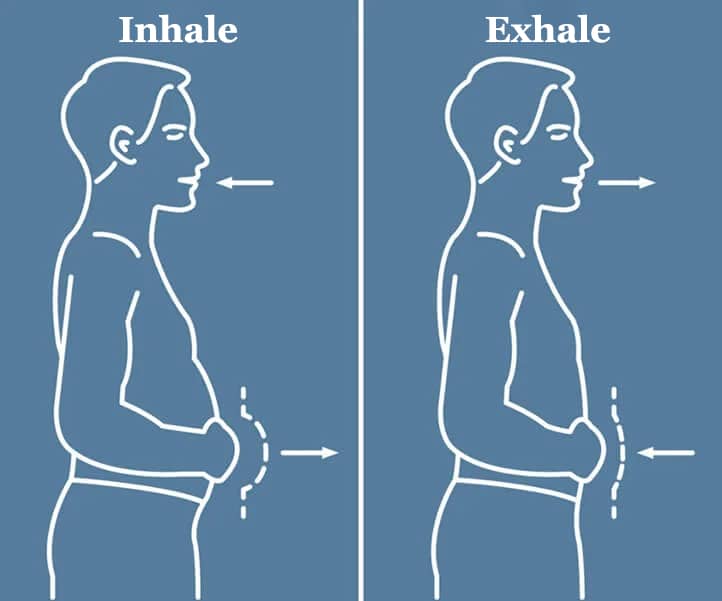We constantly face new demands and challenges at work, at home, and in personal relationships, which often lead to overload, exhaustion, and ultimately to chronic stress. This can negatively affect our physical and mental health, causing problems such as insomnia, headaches, high blood pressure, anxiety and depression.
However, there is a simple and effective solution that helps manage stress and regain inner peace. This solution is diaphragmatic breathing, an ancient practice used in various cultures to achieve a state of calm and relaxation.
Diaphragmatic breathing, also known as abdominal or deep breathing, is a simple yet powerful technique that can significantly impact anyone’s physical and mental well-being by reducing stress levels, improving focus, and boosting energy.

What is diaphragmatic breathing?
Diaphragmatic breathing is a type of breathing that emphasizes the use of the diaphragm, the muscle that separates the chest cavity from the abdomen. During inhalation, the diaphragm moves down, creating negative pressure in the chest and allowing the lungs to fill with air. During exhalation, the diaphragm moves up, helping to push air out of the lungs.
The difference between chest and diaphragmatic breathing
It’s important to understand the difference between diaphragmatic and chest breathing:
- Chest breathing occurs when inhalation is achieved by raising the chest and shoulders. This is a more shallow type of breathing that does not allow the lungs to fully fill with air.
- Diaphragmatic breathing engages the diaphragm to provide a deeper, more effective inhalation. This type of breathing is naturally used by infants and young children.
Diaphragmatic breathing is more natural and efficient because it allows the lungs to fully fill with air, providing better oxygen saturation in the blood and removing carbon dioxide from the body.
History and traditions of diaphragmatic breathing
Diaphragmatic breathing has been used in various cultures and religions for thousands of years to achieve calm, relaxation, and spiritual growth.
- Yoga. In Indian yoga philosophy, diaphragmatic breathing, known as “pranayama,” is considered key to controlling the body’s and mind’s energy. Many asanas (yoga poses) are specifically designed to facilitate diaphragmatic breathing.
- Buddhism. In Buddhist traditions, the practice of mindful breathing, or “anapanasati,” is an important part of meditation and the path to enlightenment. Diaphragmatic breathing helps calm the mind and brings it to a state of presence in the present moment.
- Chinese martial arts. In practices like Tai Chi and Qigong, diaphragmatic breathing is used to develop inner strength, concentration, and balance of energy.
- Western traditions. Although diaphragmatic breathing may seem like a new concept in the Western world, it was used in Christian monastic traditions to achieve a state of peace and prayerful contemplation.
These ancient traditions recognize the immense value of diaphragmatic breathing for physical, mental, and spiritual well-being. Today, this practice is becoming increasingly popular in modern society as a means of reducing stress and achieving inner balance.

Benefits of diaphragmatic breathing
The health and wellness benefits of diaphragmatic breathing are truly remarkable. This ancient technique, used in various cultures and traditions for millennia, has become the subject of numerous modern scientific studies, confirming its powerful potential to reduce stress and improve physical and mental health.
Regular practice of breathing exercises can become your secret weapon for achieving inner balance and improving overall well-being, helping you cope with everyday challenges and enjoy moments of calm and well-being.
Reducing stress and anxiety
Diaphragmatic breathing helps activate the parasympathetic nervous system, which is responsible for the body’s “rest and restore” response.
With regular practice of diaphragmatic breathing, stress hormone levels decrease, helping to enter a state of calm. Additionally, it can ease symptoms of anxiety such as a racing heartbeat, dizziness, and nervousness.
Improving concentration and mental clarity
Diaphragmatic breathing helps calm the mind, soothing and clearing consciousness. During practice, you shift your attention to your breathing, which allows you to detach from worrisome thoughts and focus on the present moment.
Diaphragmatic breathing is especially beneficial for students and professionals who need to maintain a high level of concentration for extended periods. Regular breaks for a few minutes of diaphragmatic breathing help “reset” the mind and keep thinking clear.
Boosting energy and vitality
A lack of oxygen in the body can lead to fatigue and sluggishness. Since diaphragmatic breathing provides better oxygen saturation in the blood, it boosts energy levels.
With diaphragmatic breathing, the lungs fill with more air, which allows more oxygen to be delivered to the body’s cells. This, in turn, contributes to a more efficient release of energy from the nutrients we consume.
Additionally, diaphragmatic breathing stimulates the lymphatic system, which plays an important role in removing toxins and waste from the body. When the lymphatic system functions optimally, the body’s productivity increases, giving you a sense of freshness and vitality.
Many people who begin to practice diaphragmatic breathing regularly note that they feel less fatigued and have more energy to carry out daily tasks.
Easing symptoms of certain health conditions
In addition to general health benefits, diaphragmatic breathing is helpful in alleviating symptoms of certain specific conditions, such as:
- Insomnia. Practicing diaphragmatic breathing before bedtime helps calm the mind and body, making it easier to fall asleep. A study published in the journal “Applied Psychophysiology” found that patients suffering from insomnia who practiced breathing exercises fell asleep faster and slept longer than the control group.
- High blood pressure. Diaphragmatic breathing promotes relaxation and reduces stress levels, which contributes to lowering blood pressure. According to a study published in the journal “Hypertension,” eight weeks of diaphragmatic breathing practice led to significant reductions in both systolic and diastolic blood pressure in patients with hypertension.
- Chronic pain. Diaphragmatic breathing can reduce the perception of pain by increasing the body’s level of endorphins (natural painkillers). One study found that patients with chronic low back pain who practiced abdominal breathing reported reduced pain intensity and improved quality of life.
- Respiratory conditions. In certain conditions, such as asthma or COPD (chronic obstructive pulmonary disease), diaphragmatic breathing helps improve lung function and ease symptoms. Regular practice strengthens respiratory muscles and improves gas exchange in the lungs.
It’s important to note that while diaphragmatic breathing is a useful complement to traditional treatment, it should not be considered a replacement for medical care. If you have a serious condition, be sure to consult your doctor.

How to practice diaphragmatic breathing?
Mastering the art of diaphragmatic breathing is easier than it may seem at first glance. With just a few simple steps, you can unlock the world of calm and relaxation hidden in deep, mindful breathing.
Regardless of age, lifestyle, or fitness level, diaphragmatic breathing is accessible to everyone. By following simple instructions, you can turn this breathing technique into a habit that will become your reliable companion in achieving inner balance and managing stress.
- Find a comfortable position. Start by finding a comfortable position for your body. It’s important to avoid tension in your muscles and spine to breathe freely. You can sit cross-legged on the floor, sit in a chair with a straight back, or lie on your back with your knees bent and your feet flat on the floor. If you feel tension in your neck or shoulders, try tilting your head slightly forward to create more space for breathing.
- Place a hand on your abdomen. Place one hand on your navel area to feel the movement of the diaphragm during breathing. This will help you focus and avoid raising your chest while inhaling.
- Take a slow deep breath through your nose. Inhale slowly and deeply through your nose, trying to direct the air to the lower part of your abdomen. You should feel the hand resting on your abdomen rise slightly as you inhale. Try to keep your chest and shoulders still.
- Hold your breath. After a full inhale, hold your breath for a second, enjoying the feeling of your lungs filling. This helps to focus and deepen the breathing.
- Exhale slowly through a slightly open mouth. Exhale slowly and smoothly through a slightly open mouth, feeling the air leave your lungs. Try to empty your lungs completely, but don’t force the exhale. Imagine tension and stress leaving your body with each exhale.
- Repeat several times. Repeat this exercise several times, focusing on the sensations created by diaphragmatic breathing. Visualize how each inhale brings fresh oxygen into your body, and each exhale releases stress and tension.
Start with a few breathing cycles and gradually increase the length of your session to 5-10 minutes or more. Over time, you’ll notice that entering a state of relaxation and calm becomes easier.
Tips for beginners
If you’re new to diaphragmatic breathing, here are some tips to help you get started:
- Take some time to observe your natural breathing rhythm before moving on to diaphragmatic breathing. This will help you become more aware of the difference.
- If you have difficulty with diaphragmatic breathing while sitting, try lying on your back. This may make it easier for the diaphragm to move.
- Don’t worry if it doesn’t come naturally the first time. Regular practice will help you master this technique.
- For extra comfort, use a pillow under your head or knees if you practice while lying down.
When to practice?
It’s important to dedicate a few minutes each day to diaphragmatic breathing. Over time, this will become a habit, and you’ll be able to use this technique in any stressful situation to achieve immediate relaxation and calm.
Here are the best times to practice diaphragmatic breathing:
- In the morning, to start the day with a clear and calm mind.
- During short breaks at work to relieve stress.
- Before important meetings or presentations to combat anxiety.
- Before bed to help you fall asleep.
- In any stressful situation when you feel yourself getting nervous or anxious.

Overcoming Difficulties
While diaphragmatic breathing may seem simple, some people may encounter challenges when learning this technique. Here are some common problems and tips for overcoming them:
Difficulty with Focus
Many people find it hard to focus during diaphragmatic breathing as their minds keep wandering to other thoughts. To overcome this, try the following:
- Perform exercises in a quiet place with minimal distractions;
- Use breath counting to maintain focus;
- Visualize a calming scene, such as a beach or forest, during your breathing;
- Listen to soothing music or nature sounds as background.
With time and practice, your ability to focus on your breath will improve.
Tension in the Upper Body
Some people feel tension in their shoulders, neck, or chest during diaphragmatic breathing, which can hinder smooth breathing. To avoid this, try:
- Consciously relax the muscles in your upper body before starting, doing light stretches or gentle sways;
- Place one hand on your chest to remind yourself not to raise it while inhaling;
- Practice diaphragmatic breathing in a relaxed position, such as lying on your back;
- Use positive affirmations like “I relax my shoulders and let my breath flow freely.”
Shallow Breathing
Sometimes, people continue to take shallow breaths, even when trying to practice diaphragmatic breathing. In this case, try:
- Place one hand on your abdomen to feel it expand with each breath, and the other hand on your chest to ensure it stays still;
- Practice in front of a mirror to visually monitor your diaphragm’s movement;
- Use calming affirmations like “I breathe deeply into my belly, filling my lungs with air”;
- Breathe in and out through your nose to slow your breath.
Dizziness or Rapid Heartbeat
In rare cases, some individuals may experience slight dizziness or an increased heart rate while practicing diaphragmatic breathing. This can be due to a temporary decrease in carbon dioxide levels in the blood from deeper breathing.
If you experience these symptoms, don’t worry. Simply take a break and return to your normal breathing. With time and practice, your body will adapt to the changes in breathing.
Also, remember that if you have any chronic respiratory or cardiovascular conditions, it’s important to consult your doctor before starting this practice.
Mastering diaphragmatic breathing requires patience and regular practice. Don’t be discouraged if it doesn’t come easily at first. Over time and with practice, you’ll be able to fully enjoy the benefits of this amazing breathing technique.

Research and Scientific Evidence on the Benefits of Diaphragmatic Breathing
While diaphragmatic breathing has been practiced in various cultures for thousands of years, only in recent decades has modern science been able to fully reveal and document its numerous health benefits. Thanks to advances in medical research, scientists have been able to study the effects of this ancient practice on the physiological and psychological processes of the human body.
The results are impressive: numerous studies conducted at leading universities and medical institutions worldwide demonstrate the remarkable benefits of diaphragmatic breathing for reducing stress, improving cognitive functions, managing pain, and even treating certain chronic conditions. These scientific findings not only confirm the wisdom of ancient traditions but also open new possibilities for integrating diaphragmatic breathing into modern health and wellness approaches.
Reducing Stress and Anxiety
A study conducted at Harvard Medical School found that practicing diaphragmatic breathing can significantly reduce levels of stress and anxiety. Participants who practiced this technique for 20 minutes a day over eight weeks showed a marked reduction in cortisol levels (the stress hormone) and improvements in mental health indicators.
Another study, published in the journal Psychosomatic Medicine, found that diaphragmatic breathing can be effective in treating generalized anxiety disorder (GAD). Patients who learned this technique reported significant reductions in anxiety symptoms and an improvement in quality of life.
Improving Lung Function and Breathing
Research conducted at the University of Iowa demonstrated that diaphragmatic breathing can improve lung function and gas exchange efficiency. Participants who practiced this technique for six weeks showed an increase in lung volume and improved oxygen saturation levels in the blood.
Another study found that diaphragmatic breathing can be a useful complement to the treatment of patients with chronic obstructive pulmonary disease (COPD). Participants who practiced this technique reported relief from symptoms such as shortness of breath and fatigue.
Lowering Blood Pressure
A report published in the journal Evidence-Based Complementary and Alternative Medicine found that diaphragmatic breathing is effective in lowering blood pressure. An analysis of several studies revealed that regular practice of this technique can lead to significant reductions in both systolic and diastolic blood pressure.
Improving Cognitive Functions and Performance
A study conducted at Stanford University demonstrated the positive effects of diaphragmatic breathing on cognitive functions and performance. Participants who practiced this technique before completing tasks requiring attention and memory performed better than those in the control group.
Another study, published in the journal Psychophysiology, found that diaphragmatic breathing enhances learning and memory retention. Participants who practiced this technique before learning tasks showed better results than those who did not.
These scientific findings highlight the broad spectrum of benefits diaphragmatic breathing offers for various aspects of physical and mental health. From reducing stress and improving lung function to boosting cognitive abilities and performance, this simple breathing technique can have a significant positive impact on your overall well-being.

Integrating Diaphragmatic Breathing into Daily Life
Diaphragmatic breathing is not just another wellness practice to do occasionally in the evening. In fact, the true power of this technique is unlocked when it becomes an integral part of your lifestyle, smoothly integrating into your daily rhythms and habits.
Every moment—whether at work, at home, or on the go—can become an opportunity for a few deep, mindful breaths that help you stay calm, focused, and balanced amid the whirlwind of daily tasks and stresses. Making diaphragmatic breathing a habit means having a powerful tool for well-being always within reach.
At Work
- Make diaphragmatic breathing part of your breaks. Spend 5-10 minutes in the middle of the day focusing on calming breaths to relieve stress and pressure.
- If you feel tension or stress at work, take a few deep breaths using your diaphragm. This will help maintain calm and mental clarity.
- Before important meetings or presentations, take a few minutes to practice diaphragmatic breathing to reduce anxiety and calm your nerves.
At Home
- Start your day with a short diaphragmatic breathing session. It can become a soothing morning practice that helps you focus and prepare for the daily routine ahead.
- Integrate diaphragmatic breathing into hobbies like yoga, meditation, nature walks, or gardening. This will enhance the relaxing effect of these activities.
- Practice diaphragmatic breathing while doing household chores, like cooking, cleaning, or laundry. This will turn everyday tasks into opportunities for relaxation and energy renewal.
During Travel
- If you commute by public transport or car, use this time to practice diaphragmatic breathing and begin your day calmly and focused.
- In airports, train stations, or queues, use the waiting time as an opportunity for a few minutes of relaxing breathing.
- During travel, especially on long flights, regularly practice diaphragmatic breathing to reduce stress and fatigue from traveling.
Over time, you will be able to use this valuable technique in any situation where you feel the need to reduce stress, calm yourself, or focus.

Diaphragmatic Breathing for Children
Diaphragmatic breathing is not only beneficial for adults but can also greatly benefit children. Teaching children this essential relaxation technique from an early age helps them develop skills that will serve them throughout their lives.
Benefits of Diaphragmatic Breathing for Children
- Reducing stress and anxiety. Children often experience stress and worry due to factors such as school, peer pressure, or family issues. Diaphragmatic breathing helps them find inner calm.
- Improving concentration and academic performance. Practicing diaphragmatic breathing enhances children’s ability to focus and absorb new information, positively affecting their academic success.
- Developing emotional resilience. Diaphragmatic breathing is a self-regulation technique that helps children develop healthier strategies for dealing with stress and challenges.
- Strengthening the respiratory system. Since diaphragmatic breathing engages the entire lung capacity, it promotes better respiratory function and overall health in children.
How to Teach Children Diaphragmatic Breathing?
Teaching children diaphragmatic breathing can be fun and engaging. Here are some tips:
- Use games and imagination. Turn the practice into a game by asking children to imagine inflating a large balloon in their belly when they inhale and slowly deflating it when they exhale.
- Be a role model. Children learn best by example. Practice diaphragmatic breathing with them, showing the correct technique.
- Use visual cues. Place a small toy or book on the child’s belly so they can see it rise and fall with their breathing.
- Make it part of their daily routine. Incorporate short diaphragmatic breathing sessions into the child’s daily schedule, such as before school, bedtime, or during breaks from homework.
- Be patient. Don’t expect the child to master the technique immediately. With time and regular practice, diaphragmatic breathing will become second nature to them.
Teaching children diaphragmatic breathing will not only benefit their physical and mental health in the present but also provide them with a lifelong tool for managing stress and achieving inner balance.

Diaphragmatic Breathing and Meditation
Diaphragmatic breathing and meditation are two ancient practices that have long been used together to achieve inner peace and harmony. For centuries, various spiritual traditions have harnessed their power as effective tools to release emotional tension and deepen the connection between body and mind.
When combined, these two disciplines open new dimensions of mindfulness and relaxation. Focusing on the rhythmic movement of the diaphragm during breathing can serve as an anchor, keeping your attention in the present moment during meditation. Meanwhile, a meditative state of mind allows for complete immersion in the breathing process, enhancing its healing effects. The synergy of these practices creates a powerful alliance for achieving inner balance and well-being.
How does diaphragmatic breathing complement meditation?
- Focus: In meditation, the goal is to focus attention on one object, such as breath or a mantra. Diaphragmatic breathing provides a clear focal point, helping to keep the mind in the present moment.
- Calming the mind: Both diaphragmatic breathing and meditation calm the mind, reducing activity in the brain regions responsible for anxiety and worry.
- Increasing awareness: Practicing diaphragmatic breathing during meditation helps develop a deeper awareness of your physical and mental state, allowing for better recognition and regulation of emotions and thoughts.
- Enhancing relaxation: The combination of meditation and diaphragmatic breathing can deepen the relaxation state by activating the parasympathetic nervous system, responsible for the “rest and restore” response.
How to practice diaphragmatic breathing in meditation?
- Find a comfortable posture. Sit cross-legged or in any position where you can remain still for a few minutes.
- Begin your breathing practice. Take a few cycles of diaphragmatic breathing, paying attention to the sensation of each inhale and exhale.
- Transition into meditation. After a few cycles, shift your focus to your meditation object, such as the feeling of air entering and leaving your nostrils, or repeating a mantra.
- Return to breathing. If your mind starts to wander, gently bring it back to diaphragmatic breathing before refocusing on the meditation object.
With regular practice, the combination of diaphragmatic breathing and meditation will become more natural and effective.
Integrating diaphragmatic breathing into meditation allows for deeper relaxation, mindfulness, and inner peace. Over time, you will see that these two practices not only complement but also enhance each other.

Diaphragmatic Breathing for Pregnant Women
Pregnancy is a beautiful yet often stressful time in a woman’s life. Hormonal changes, physical discomfort, and the anticipation of childbirth can lead to anxiety and worry. During this special time, diaphragmatic breathing becomes a valuable ally, helping expectant mothers stay calm, manage emotions, and better prepare for labor.
This ancient practice not only provides emotional relief but also offers physical benefits during pregnancy. Deep breathing improves circulation, delivering more oxygen to the fetus, while mindful exhalations help relax tense muscles and alleviate common discomforts.
Benefits of diaphragmatic breathing for pregnant women
- Reducing stress and anxiety: Diaphragmatic breathing helps pregnant women manage emotional tension and concerns related to pregnancy and childbirth.
- Relieving pain and discomfort: It can reduce the perception of pain and alleviate symptoms such as heartburn, swelling, and muscle cramps, which are common during pregnancy.
- Preparing for childbirth: Mastering diaphragmatic breathing helps mothers better prepare for labor, as this technique is often used during contractions to manage pain and tension.
- Improving circulation: It enhances blood circulation, ensuring sufficient oxygen and nutrients reach the developing fetus.
How to practice diaphragmatic breathing during pregnancy?
- Find a comfortable position. Choose a position where you can breathe easily, whether sitting, semi-reclining, or lying down with pillows supporting your back and belly.
- Focus on your breath. Take slow, deep breaths through your nose, directing air into the lower abdomen. Try to engage your diaphragm as much as possible during each inhale.
- Visualize. As you practice diaphragmatic breathing, visualize your belly gently rising with each inhale and falling with each exhale. This helps maintain focus on the process.
- Relax your muscles. With each exhale, relax your abdominal, pelvic, and leg muscles, releasing any physical tension.
It’s recommended to practice diaphragmatic breathing daily for 10–15 minutes or more if needed.
Always consult your doctor before starting any new practice during pregnancy. They can provide additional guidance or precautions specific to your health condition.

Diaphragmatic Breathing and Physical Exercise
Diaphragmatic breathing is not just a relaxation technique but also a powerful tool for improving exercise performance and speeding up recovery. Proper breathing plays a crucial role in optimizing muscle function, delivering oxygen, and eliminating waste products during workouts.
By incorporating diaphragmatic breathing into your fitness routine, you unlock new levels of performance, endurance, and overall well-being, making it a secret weapon for reaching peak physical condition and maximizing the benefits of every workout.
Benefits of diaphragmatic breathing during exercise
- Enhanced oxygen supply: Diaphragmatic breathing allows for deeper breaths, increasing oxygen intake into the bloodstream and muscles, helping you endure intense activity for longer.
- Increased endurance: Proper breathing prevents lactic acid buildup in muscles, delaying fatigue and boosting overall endurance.
- Faster recovery: This breathing technique helps efficiently remove carbon dioxide and other waste products, speeding up post-workout recovery.
- Reduced injury risk: Diaphragmatic breathing relaxes muscles, reducing the chance of strain and injury during exercise.
- Improved focus: Focusing on your breath during workouts sharpens your technique, reducing injury risks and improving exercise effectiveness.
How to integrate diaphragmatic breathing into exercise?
- Warm-up and cool down: Begin and end each workout with a few minutes of diaphragmatic breathing to prepare your body and mind for the physical effort and enhance recovery.
- High-intensity exercises: During intense cardio or strength exercises, try to breathe diaphragmatically, inhaling deeply through your nose and exhaling through your mouth.
- Stretching and flexibility: When performing stretching or flexibility exercises, pair the movements with diaphragmatic breathing to maximize muscle relaxation.
- During breaks: Practice a few cycles of diaphragmatic breathing during short breaks between sets or intervals to lower your heart rate and regain control of your breathing.
- Post-workout: After completing your workout, dedicate a few minutes to breathing exercises to help your body transition to recovery mode.
Be patient as you incorporate diaphragmatic breathing into your fitness routine—it takes time to adapt, but the benefits are worth it.

Diaphragmatic Breathing for Pain Management
Pain is an unpleasant yet inevitable aspect of life. Whether from an acute injury or a chronic condition, pain can significantly reduce quality of life.
However, there is a simple tool that can help alleviate suffering—diaphragmatic breathing. By promoting the production of natural painkillers, reducing muscle tension, and lowering stress levels, it offers a safe and effective way to manage pain.
How does diaphragmatic breathing help manage pain?
- Stimulating endorphin production: Diaphragmatic breathing encourages the release of endorphins—the body’s natural painkillers. Endorphins bind to receptors in the brain and body, reducing the sensation of pain.
- Reducing muscle tension: Pain is often exacerbated by muscle tension, creating a vicious cycle of discomfort. Breathing exercises promote muscle relaxation, easing tension and related pain.
- Lowering stress and anxiety: As breathing practice reduces stress hormones, it can lessen pain perception associated with anxiety and tension.
- Increasing awareness: Focusing on diaphragmatic breathing helps divert attention away from pain and fosters a calmer presence in the moment.
- Improving circulation: Diaphragmatic breathing stimulates blood flow, promoting the delivery of nutrients and oxygen to painful areas, speeding up the healing process.
Applying diaphragmatic breathing for pain management
- Daily practice: Regular diaphragmatic breathing practice helps develop a skill that can be used during painful periods.
- During pain episodes: When experiencing acute or chronic pain, take several cycles of diaphragmatic breathing to relax and alleviate discomfort.
- Combine with visualization: During breathing practice, visualize your body relaxing and the pain lessening with each exhale.
- Complement other treatments: Diaphragmatic breathing can be used alongside medications, physical therapy, or other treatments to improve pain management.
- In rehabilitation programs: For patients undergoing rehabilitation after injury or surgery, diaphragmatic exercises can be a useful tool for reducing pain and speeding recovery.
It is important to note that diaphragmatic breathing is not a cure-all for pain and should not be considered a replacement for traditional medical treatment. However, it can be used as an adjunctive therapy to enhance pain-relieving effects and improve overall well-being. Consulting with your doctor will help determine how best to do this.

Diaphragmatic Breathing to Music
Music has an amazing ability to touch the deepest strings of the human soul, evoking a wide range of emotions and states. When its harmonious notes are combined with the rhythmic movement of the diaphragm, a truly magical experience of relaxation and inner peace is born.
The fusion of music and diaphragmatic breathing creates a multisensory environment that one can fully immerse in. The melodies serve as a guide for the breathing rhythm, while the inhales and exhales act as an anchor, keeping you in the present moment. This synergistic interaction enhances the benefits of each breathing practice, creating a deep state of peace and relaxation for the mind and body.
How does music complement diaphragmatic breathing?
- Setting the rhythm. The musical rhythm serves as a guide for the breathing pattern. You can synchronize your inhales and exhales with specific musical phases or beats.
- Focusing attention. Combining music and breathing creates an additional object of focus, distracting you from intrusive thoughts.
- Creating a mood. Calm, melodic music soothes and relaxes, complementing and enhancing the effects of diaphragmatic breathing.
- Stimulating imagination. Music can stimulate imagination and visualization, helping you delve deeper into the breathing practice.
- Emotional engagement. Music has the power to touch a person’s emotions, making diaphragmatic breathing more personal and meaningful.
Choosing the right music
When selecting music to accompany your breathing practice, it’s important to consider the following:
- Tempo. Choose music with a slow or moderate tempo that won’t provoke rapid breathing.
- Genre. Good choices include genres such as new age, ambient, classical music, or instrumental compositions.
- Volume. Avoid music that is too loud, which may distract or cause anxiety. The ideal volume level should be soft enough to focus on breathing.
- Personal preferences. Ultimately, choose the music that calms you.
Experiment with different musical genres and styles until you find what resonates best with your inner state. Combining music and breathing will transform your practice into a truly multisensory and enriching experience.

Conclusion
Diaphragmatic breathing is a simple but effective technique that promotes physical and mental well-being. From reducing stress and anxiety to increasing energy and concentration, regular practice of breathing exercises can become your secret weapon in combating stress and achieving inner balance.
Incorporate diaphragmatic breathing into your daily life, dedicating just a few minutes to it each day. Enjoy the feeling of calm and relaxation it brings. Remember that you hold the key to improving your well-being—sometimes, all it takes is breathing in a certain way.
The human body is amazing: it knows how to restore balance on its own. Just give it that chance through diaphragmatic breathing. Start practicing today and discover the path to greater peace.




